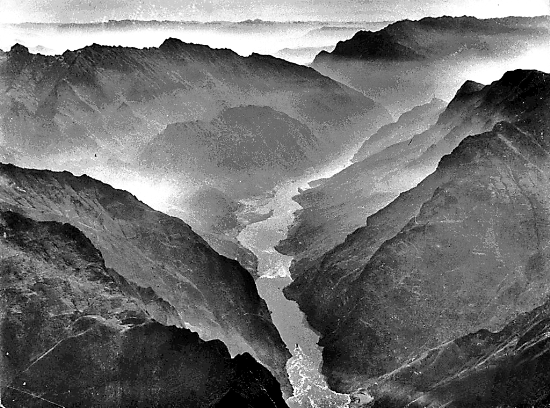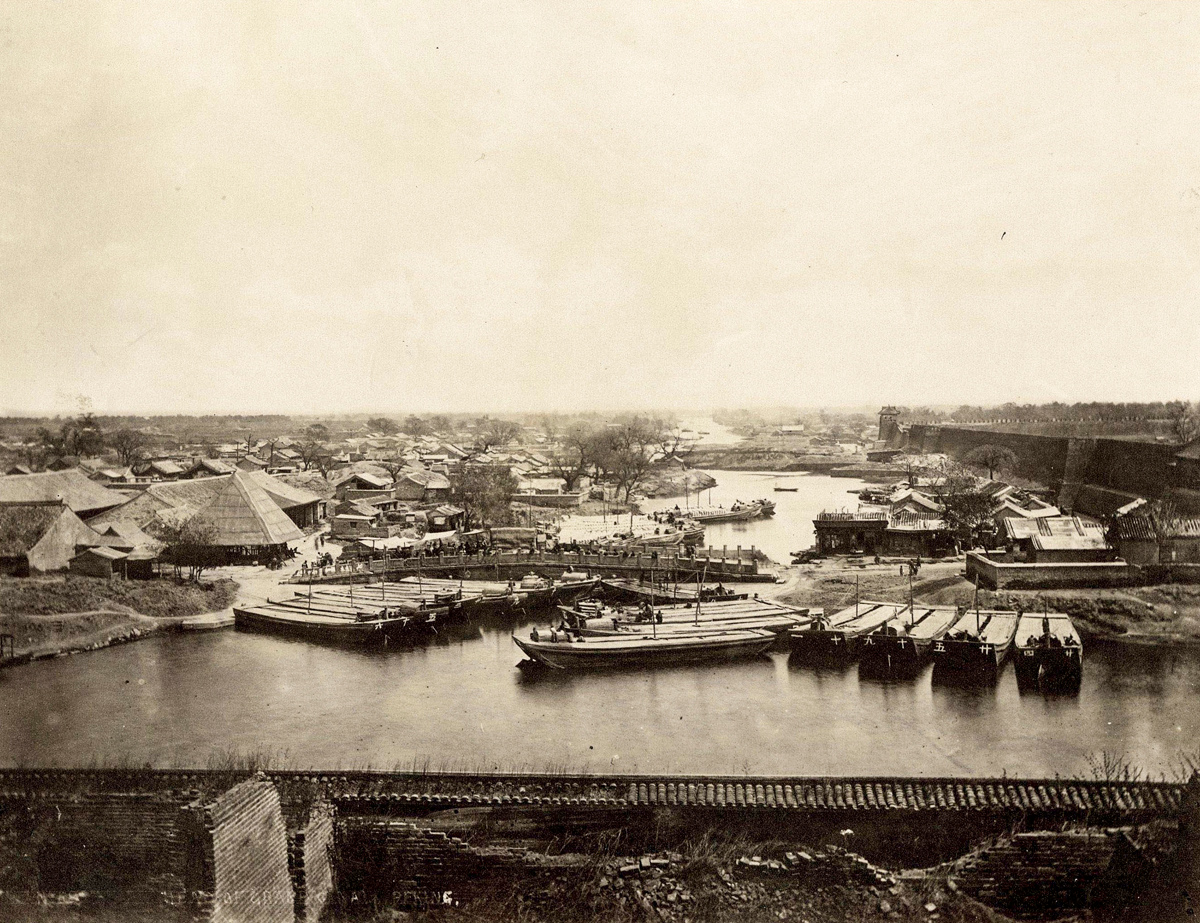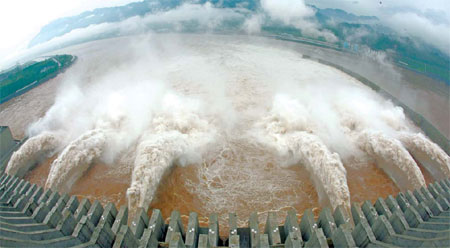China's Water Crisis:
A Timeline

Two Great Rivers
China is defined by its two great rivers: The Yellow River and
the Yangtze River. For millions of years these rivers have
formed the lifeblood of Chinese civilization. The the Yangtze
has always played a critical role in the transportation of
goods, while the Yellow River, also kown as the "Mother River",
is a source of rich fertile soil and irrigation water.
With good, however, always must come struggle. These rivers
periodically transform themselves into raging torrends, sweeping
away entire villiages. The paradox is, the river that is
necessary for life to flourish, is also responsible for the most
death and destruction. Throughout history, China’s national
identity has been shaped by it's struggle to control these
waters.
This theme runs deep through Chinese culture. Every Chinese
schoolchild knows the story of Yu The Great, the legendary first
ruler in ancient China, who tamed the raging flood.
2000 BC

Great Yu Controls the Waters
As the story goes, Yu grew up watching his father, the ruler,
build a series of dikes and dams along the river in an attempt
to control the floods. Time and time again the river overpowered
his dams. After nine years Yu took his fathers place as ruler,
and decided to approach this problem differently. Instead of
blocking and disturbing the river's natural course, Yu devised a
system of irrigation canals, which diverted the flood waters
into fields. This system allowed ancient Chinese culture to
flourish along the Yellow River, Wei River, and other waterways
of the Chinese heartland. This project was so successful that he
earned the title "Yu The Great", and is celebrated still today.
Though he may be mythical, Yu The Great set the precedent for
rulers to come, many of whome have attempted methods of
harnessing the waters.
468 BC

The Grand Canal
Many will claim that the canals created by Yu the Great form the first section of the Grand Canal, which stretches 1,104 miles and connects the two great rivers. Creating this canal was the life work of several rulers throughout history, before it was completed during the Sui dynasty (581–618 CE). Beginning in the thirteenth and fourteenth centuries, the Grand Canal was the primary route for grain and other commodities from south China to reach the capital city that would become Beijing, making it vital part of economic life in early China. The canal eventually fell into disuse, but recently is being revived.
"To some extent, China’s leaders today are still judged by their
ability to harness the waters"
- Judith Shapiro
Author of China's Environmental Challenges
1949 - 1976

Mao Zedong
In 1949 Communist Party Chairman Mao Zedong took power. Like the
generations of rulers that came before him, Mao too dreamed of
harnessing the waters. He became fascinated with the idea of
overpowering the great force of the Yangtze River. In a poem, he
wrote:
A bridge will fly to span the north and south,
Turning a deep chasm into a thoroughfare;
Walls of
stone will stand upstream to the west
To hold back
Wushan's clouds and rain
Till a smooth lake rises in the
narrow gorges.
The mountain goddess if she is still
there
Will marvel at a world so changed.
In this he dreamed of the Three Gorges Dam, but the Chinese
economy was not yet strong enough to support such a project. He
also dreamed of a way in which the abundant water in the south
could be harnessed for use in the more industrialized north:
"there's plenty of water in the south, not much water in the
north. If at all possible; borrowing some water would be good."
Mao's big ideas were not without opposition. Hydroengineer and
Professor Huang Wanli, warned that it was a poor idea to dam the
main stream of a great river. Like the great Yu, he suggested
working with the water rather than against it. Diverting the
water could provide more effective flood control, and a series
of smaller, less destructive dams could provide the same amount
of hydropower.
1994 - 2012

The Three Gorges Dam
In the post-Mao era came economic reform, and China's economy
grew rapidly as it became "the world's factory". With this
growth came an increaseing need for energy, to fuel the
production and increase in population. The government turned to
the Three Gorges Dam that Mao had long dreamed of, in the hopes
that it would generate much needed power and control the
devastating floods.
Construction of the dam began in 1994 and was completed in 2012.
The Three Gorges Dam is the world’s largest power station in
terms of the energy it generates, with a capacity of 22,500
megawatts, which reduces China’s dependency on coal. The dam
also allows large ships to travel up and downstream. For the
first time, ships from Chongquing will be able to transport
goods all the way to the sea at Shanghai.

This accomplishment however comes with many losses. The dam
engulfed 13 cities, 140 towns, 1,352 villages and about 650
factories. It displaced 1.3 million people whose homes, culture
and history were washed away with the river. It destroyed the
iconic scenery of the Qutang, Wu, and Xiling gorges, along with
countless archaeological sites. Human and industrial waste from
cities below polluted the waters of the Yangtze. Moreover, the
enormous amount of water trapped within the gorge has caused
multiple large landslides. The overall ecology of the river
system has been irreversibly damaged, and several species have
been driven to extinction. Below the dam, reduced sedimentation
creates less fertile soil, which harms the crop production of
villiagers downstream.
2007

Pollution Worsens
With the rapid growth of China's economy came an enormous amount
of pollution, for which China was unprepared. About one third of
the industrial waste water and more than 90 percent of household
sewage in China is released into rivers and lakes without being
treated. Nearly 80 percent of China's cities have no sewage
treatment facilities.
In a lake in Wuhan, central China's Hubei province, more than
110,000 pounds of fish died due to pollution and hot weather.
This example depicts what is happening in lakes and rivers
across China.
"We have seen this in most countries. Income per capita, or economic
growth, is directly tied to an increase in pollution."
- Dr. Shana McDermott
Environmental Economics Professor at Trinity University
2011

Cancer Villiages
For many villiages along the rivers, industrialization has
brought a plague to their citizens. Above, a villiager blames
the polluted stream and well water for the illness and death
plaguing her village. The cluster of paper and chemical
factories upstream is discharging polluted waste water into the
stream the villiagers rely on for their drinking, washing and
cooking water.
The rates of cancer in these villages are shocking. Many of the
cancer victims are in their youth, and many of them have rare
cancers of the esophagus, rectum, stomach and liver. The death
rate is high, as many villiagers cannot afford treatment.
2011

The Mother River Runs Dry
Just as The Yellow River was needed at the birth of China's
civilization, it is still vital to making northern China
inhabitable. It supplies water to 155 million people, or 12
percent of the Chinese population, and irrigates 18 million
acres, 15 percent of China's farmland.
The Mother River has ceased to flow an increasing number of
times since 1972, when it ran dry for the first time in recorded
history. 80 to 90 percent of its water has been taken upstream
for urban areas, industry and agriculture. In this way,
harnessing the waters of the Yellow River has depleted this
vital resource of life.
2013 - Present

South-North Water Diversion Project
Today, the focus of the Chinese leaders still lies in gaining
power over the waters, or lack there of. The problem is one of
scarcity, and geography. Northern China holds the majority of
the population, yet the water supply is largely located in the
south. As China's population grows, water resources continue to
dwindle, and what is left continues to become increasingly
polluted. In a last-ditch effort to harness the remaining water,
China has turned yet again to a big idea first proposed by Mao
Zedong in 1952. The South-North Water Diversion Project will
channel water from the Yangzi River to the water-starved North
China Plain. This project has reopened the long forgotten Grand
Canal, which first brought life to the Chinese economy centuries
ago.
Although the project decreases the likelihood of flooding in the
south and drought in the north, the ecology of the Yangzi River
Basin has been damaged, and 300,000 people displaced. The water
from the Yangtze is polluted as well, causing cross-pollution
with the Yellow River basin.
Once again, many critics argue that attempting to inhibit the
natural course of such a large river is futile. Many people
point to alternative solutions, such as shifting the focus to
consumption, promote water conservation, increase fines for
water polluters, and cleaning up the rivers rather than fighting
against them.